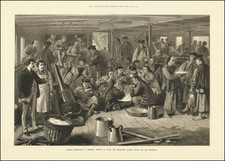This 1720 engraving is a satirical representation of the financial crisis that occurred that year, particularly focusing on the consequences of reckless investment and the speculative schemes that led to the collapse of many ventures. The engraving is rich in symbolism and imagery, depicting various scenes that illustrate the financial chaos and its impact on society.
At the center of the engraving is a triumphal arch, under which shares of failed schemes are being buried in a mass grave. The shares are printed with images such as a mousetrap, carrots, and a calf's head, representing the various speculative ventures that ultimately failed. Behind the grave stand a group of dignitaries, and an empty bier is placed in front.
Above the central arch, there is an oval portrait of John Law, a prominent figure in the financial world at the time, holding a fishing rod with a small fish. A shield with a prancing horse hangs below the portrait. Above this portrait, a scene shows Mercury being crowned with a fool's cap by Minerva, while two investors approach him, one on bended knee.
On either side of the central arch are scenes illustrating the consequences of reckless investment. On the left, horses and carriages are being sold cheaply, while on the right, a sick shareholder is being bled by a surgeon, assisted by a dog on his hind legs. The weeping wife of the sick shareholder is surrounded by small children, and creditors call at the door.
In front of the arch, various characters are depicted, including a woman holding the pall that had covered the shares, beggars, and unsuccessful investors bemoaning their loss. To the right is the funeral procession, winding its way through a city square with mourners representing various strata of society, including a man with a wooden leg and crutches, a weeping child, and two nuns. In the background, a riot can be seen continuing in the distance.
The engraving is full of symbolic elements, such as inverted cornucopias, a looking-glass, vases of tulips, an orb of sovereignty, and a cabbage. Scenes on the left show ass's milk being sold, while on the right, ships sail along the new canal between Utrecht and the Zuiderzee.
The Dutch and French titles, inscriptions, and verses in eight columns provide further context for this satirical piece. Overall, the engraving serves as a powerful commentary on the financial turmoil of the time and the consequences of speculative investment.
The title "Gedenk-boog, ter begraaf-plaats der uitgeteerde Actionisten" is in Dutch and translates to "Memorial arch at the burial place of the emaciated shareholders." The French title, "Arc memorial dressé au lieu de enterrement des Actionistes consumés," has a similar meaning: "Memorial arch erected at the burial place of the consumed shareholders." Both titles refer to the central arch in the engraving, which symbolizes the burial place for the shares of failed ventures and the disastrous consequences faced by the investors who lost their fortunes during the financial crisis of 1720. The engraving satirically memorializes the demise of these speculative schemes and the resulting hardships endured by the affected shareholders.









![For Governor, Maj. Gen. John W. Geary [Former Mayor of San Francisco / Governor of Kansas Territory and Governor of Pennsylvania]](https://storage.googleapis.com/raremaps/img/small/93592.jpg)
![[Hermann's Battle] Die Hermann's-Schlacht](https://storage.googleapis.com/raremaps/img/small/83003.jpg)
![[American Lady] [Amerika fujin] | [Chinese Man from Nanjing] [To Daishin Nankin-jin]](https://storage.googleapis.com/raremaps/img/small/55554.jpg)
![(New York City) [Original portrait of an American gentleman with New York City Street Plan]](https://storage.googleapis.com/raremaps/img/small/84607.jpg)

